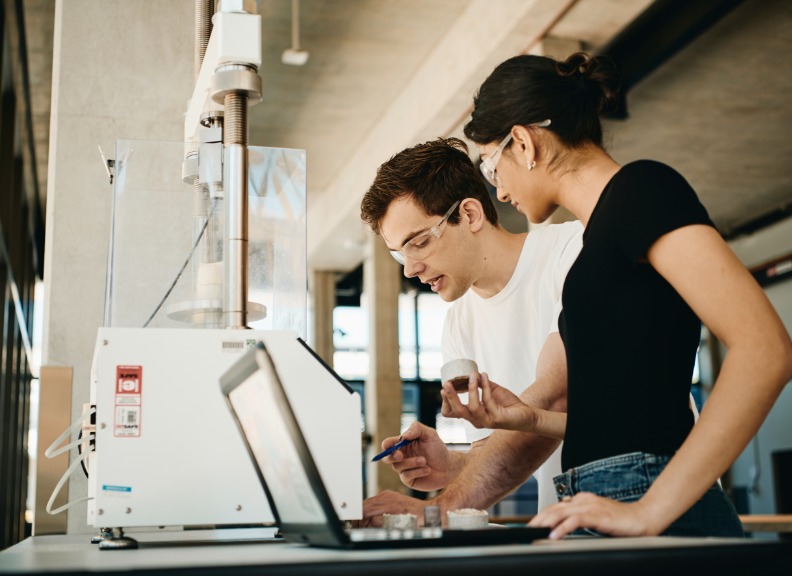Biomedical Engineering
Bioengineering solutions to global problems
The Biomedical Engineering research cluster in the School of Engineering finds innovative solutions for the biomedical imaging, biomechanics, biomaterials and engineering computational biology industries.
The team of interdisciplinary researchers are working towards better diagnosis, treatment and prevention of disease, through technologies such as new surgical imaging, visualisation and simulation techniques.
Merging engineering, computing, mathematics, life sciences and medicine, the fundamental research delves into areas including tumour biology and human physiology, through to clinical and surgical applications.
The Biomedical Engineering research cluster addresses a wide range of problems, primarily in the areas of human health. The group has a diverse range of skills and expertise, and mainly focuses on solving problems in the following areas:
- cancer
- cardiovascular disease
- brain
- medical image analysis
- physiological modelling
- computer vison and artificial intelligence
- biosensing
Current projects
Some of the projects being undertaken by the group include:
- Computational biomechanics models
- Aorta aneurysm prediction
- 3D bioprinting
- OCT/microscope in a needle
- MEMS based optical spectrometres
- GaN (gallium nitride) transistor-based sensors
- 3D printing
- Optical elastography
- Low-field NMR
Research opportunities are available for prospective students in this cluster. You can learn more by emailing the Pre-candidature team at the Graduate Research School.
Our Research Groups
- VASClab
-
VASClab uses computational and experimental techniques to further understanding of vascular physiology and disease. The team uses interdisciplinary approaches to better diagnose a range of vascular pathologies. A major aspect of its research is patient-specific modelling, primarily the application of fluid and solid computational mechanics to simulate 3D patient-specific blood flow and stresses in vivo. VASClab is also active in 3D bioprinting with a view to one day print living medical devices for implantation. VASClab is based at the Harry Perkins Institute of Medical Research, the premier medical institute in WA, as part of the Biomedical Engineering@Perkins initiative.
- BRITElab
-
BRITElab develops new imaging techniques for clinical and biological applications. In particular, the group is actively developing optical elastography, a technique that forms images of tissue mechanical properties (elasticity) at micro-scale resolution. The team is developing optical elastography for a range of applications, including tumour margin assessment in breast-conserving surgery, biomaterials characterisation, tumour biology and vascular biology. The group is interested in developing small footprint imaging and sensing for healthcare solutions in remote areas and for wearable devices. BRITElab is based at the Harry Perkins Institute of Medical Research and part of the Biomedical Engineering@Perkins initiative.
- Optical and Biomedical Engineering Laboratory
-
The Optical and Biomedical Engineering Laboratory’s research is in the fields of biomedical optics, biophotonics, and optical microscopy. It is conducted at the interface of optics, biomedical engineering, biology and clinical medicine. OBEL seeks a deeper understanding of basic optical interactions in tissues. It also builds instrumentation, deploying it in imaging and diagnostic applications with collaborators in medicine and biology.
- Intelligent Systems for Medicine Lab
-
The Intelligent Systems for Medicine Lab is interested in biomechanics (engineering biomechanics, sport biomechanics, injury biomechanics), computer-integrated surgery, image-guided surgery, medical robotics and related fields. It is an acknowledged world leader in computational biomechanics for medicine and focuses on enabling personalised medicine based on patient-specific mathematical models and scientific computations.
- Engineering Computational Biology
-
The Engineering Computational Biology group studies the physiology and dysregulation of biological systems using computational modelling. It has experience in:
- computational modelling of colon mucosa in early stages of colon cancer
- bone remodelling in relation to osteoporosis
- cartilage remodelling in relation to osteoarthritis
- tendon remodelling in relation to tendinopathy
- smooth muscle cells and calcium regulation
- fetal development and preterm birth
- eye surgery and glaucoma
- oxygenation of the kidney and hypoxia, among other projects.
- Microelectronics Research Group
-
The Biosensor Group is within the Microelectronics Research Group. It has developed the ability to monitor biological and chemical signals with electronic devices, which has applications in cell research and process control in pharmaceutical and microbiological production, and chemical sensing applications. The group has developed bio-friendly, chemically inert and stable III-Nitride-transistor-based bio/chem-sensors to detect responses to various specific compounds/chemicals, particularly through cell receptors. This electronic biosensor technology has the potential to improve health and disease treatment through major improvements in throughput, precision, quality, speed and simplicity of, for example, drug and disease testing methods.
- Bennamoun Lab
-
The Bennamoun Lab is active in the area of computer vision, robotics and automation and machine learning to solve complex interdisciplinary problems. The group has a broad range of projects in the areas of robotic vision, biometrics, audio-visual recognition (AVR), human computer interaction (HCI), machine to machine interaction (M2M), virtual and augmented reality, biomechanics, dentistry, ophthalmology, linguistics, photogrammetry, animal biology and radiology.
3D Bioprinting at UWA
Research partners and collaborators
This research area involves the following UWA staff members:
- Brendan Kennedy
- Vincent Wallace
- Barry Doyle
- Tim Sercombe
- Barry Cense
- Adam Wittek
- David Smith
- Martin Ebert
The Bioengineering discipline also works with the following collaborators:
Relevant study areas
Contact Dr Barry Doyle
Senior Lecturer, Mechanical Engineering


